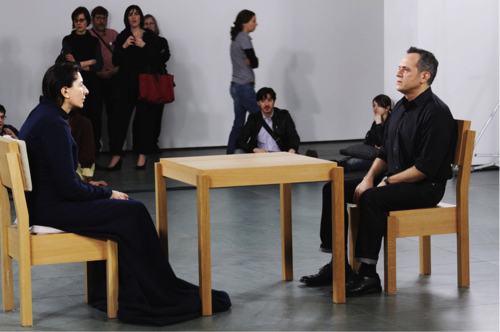Raymond W. Gibbs Jr.: “Metaphor Wars”
Freie Universität Berlin, March 8, 2016
During his one-month stay as a fellow at Cinepoetics, Raymond W. Gibbs Jr. was kind enough to give an exciting insight into his current research interests. As an expert in the fields of psychology and cognitive sciences, he presented a rewarding perspective on metaphor and film. To put this into a more film analytical context, Gibbs’ presentation was complemented by Thomas Scherer’s talk on metaphor in social advertising—a connection which proved to be productive for the subsequent discussion.
Presenting his PhD project, Scherer screened three different social advertisements against gambling, drinking and driving, and for women’s heart disease awareness. The members and fellows of the center discussed each one meticulously. Often, there are embodied messages in the commercials using an intricate sound design to appeal to the audience. It has also been remarked that often in social advertising the target domain is not introduced until the end of the advertisement.
Scherer provided insights into the continuous unfolding of verbal metaphors in an audiovisual manner. Idioms like “it’s all tied together” and “going through the glass ceiling” are presented on different cinematic levels. Here, especially the Anglophone fellows provided valuable context for further analysis of metaphors in an intercultural environment.
For his presentation, Ray Gibbs shared some ideas behind his latest book project with Cinepoetics. Being interested in non-verbal communication, Gibbs showed excerpts of the performance piece “The Artist is Present” by Marina Abramović. The artist sat on a chair facing several visitors of the gallery for over seven hours, six days per week, without uttering a single word.
In analyzing numerous comments by visitors of this performance, Gibbs described it as a non-linguistic experience that nonetheless evokes metaphors in the recipient. Nearly all of the commenters had used different metaphors to describe their experience, although there was no verbal communication between them and the artist.
Gibbs linked this to his work on psychologically based embodied metaphors like the phrase “affection is warmth.” These phrases can be found using experiments based on cognitive psychology in which participants for instance label a person as friendly-looking or not. Before they saw the person’s picture, they were asked if they wanted a hot or a cold beverage. Participants with a hot beverage tended to label the people shown as friendly, whereas participants who ordered a cold beverage preferred the opposite label.
Other metaphors like “similarity is closeness”, “morality is cleanliness”, or “importance is weight” can be validated by similar experiments. In light of these embodied metaphors that seem to exist outside of verbal communication, Gibbs asked for a different approach to conceptual metaphor theory. He elaborated further that these metaphors influence the embodied experience of language and, thus, a certain way of thinking.
Gibbs proposed a model of circular causality in which language, (bodily) experience, and thinking structure each other. Here, the relation of cause and effect cannot be generalized anymore. This dynamic model would exceed the solid structure that, according to Gibbs, conceptual metaphor theory is stuck in. Dynamicity is needed because “metaphors are something you do,” he explained in a closing remark, “and films can show us how this ‘metaphoring’ can work.”


